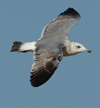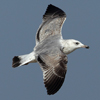 Larus armenicus
Larus armenicus
(last update:
2cy armenicus: November Armenicus in Iran - Lake Orumiyeh; continued from HERE Some information on the morphology, chemistry and sediments of the lake IN: Urmia Lake (Northwest Iran): a brief review, by: Amin Eimanifar and Feridon Mohebbi WEBSITE Data from Birdlife:  islands in Lake Orumiyeh, image Abbas Farshi, his site HERE Lake Uromiyeh lies at 1,280 m in an inland drainage basin in western Azarbayjan, 60 km south-west of Tabriz. At c.140 km long (from north-west to south-east) and up to 55 km wide near the southern end, it is a vast hypersaline lake of great scenic beauty with extensive salt-encrusted flats and shingle beaches. The average depth is c.5 m, the level fluctuating by c.12 m depending on winter rains. The bottom is mud or silt, often covered by salt crystals. Salinities range from 80 to 280 p.p.t. and the water temperature from 3 to 30C. There are several large areas of fresh to brackish marsh with abundant aquatic vegetation in the deltas of the many small rivers and streams which flow into the lake. The most extensive of these marshes is in the south at the mouth of the Jogatu Chay river. The lake includes 56, mostly small, uninhabited islands. The largest, Kabudan (Ghoyoon Daghi), comprises 3,125 ha of hilly steppe with scattered trees. The climate is semi-arid, with very hot summers and extremely cold winters (temperatures below -25C). The lake supports an abundant growth of the alga Enteromorpha and there is a very rich algal bloom and build up of brine shrimp Artemia salina between early June and the end of September, but the lake itself is too saline to support any other plants or animals. The marshes and shorelines have typical saltmarsh plant communities of Suaeda, Atriplex and Frankenia with Juncus, some Phragmites at river mouths, and occasional stands of Tamarix. Remnant stands of Pistacia forest survive on the larger islands, notably Kabudan and Ashk, together with Rhamnus bushes and Artemisia shrubs. There are rolling wheat-lands to the west and south, and semi-arid steppe and hills to the north and east. There are villages on the shore, with small steamer ferries operating between them. The lake has little value for conventional outdoor recreation because of its extremely high salinity, but has exceptionally high values for eco-tourism because of its great scenic beauty and spectacular concentrations of waterbirds. Populations of IBA trigger species:Larus armenicus 1977: 4,000-5,000 breeding pairs.
|
 Larus armenicus 2cy November 26 2010, Ashdod, Israel. Picture: Amir Ben Dov. Larus armenicus 2cy November 26 2010, Ashdod, Israel. Picture: Amir Ben Dov. |
 Larus armenicus 2cy November 02 2010, Maagan Michael, Israel. Picture: Amir Ben Dov. Larus armenicus 2cy November 02 2010, Maagan Michael, Israel. Picture: Amir Ben Dov. |
|
 Larus armenicus 2cy November 02 2010, Maagan Michael, Israel. Picture: Amir Ben Dov. Larus armenicus 2cy November 02 2010, Maagan Michael, Israel. Picture: Amir Ben Dov. |
|
 Larus armenicus 2cy November 02 2010, Maagan Michael, Israel. Picture: Amir Ben Dov. Larus armenicus 2cy November 02 2010, Maagan Michael, Israel. Picture: Amir Ben Dov. |
|
 Larus armenicus 2cy November 15 2010, Maagan Michael, Israel. Picture: Amir Ben Dov. Larus armenicus 2cy November 15 2010, Maagan Michael, Israel. Picture: Amir Ben Dov. |
|
 Larus armenicus 2cy November 15 2010, Maagan Michael, Israel. Picture: Amir Ben Dov. Larus armenicus 2cy November 15 2010, Maagan Michael, Israel. Picture: Amir Ben Dov. |
|
 Larus armenicus 2cy November 15 2010, Maayan Zvi, Israel. Picture: Amir Ben Dov. Larus armenicus 2cy November 15 2010, Maayan Zvi, Israel. Picture: Amir Ben Dov. |
|
 Larus armenicus 2cy November 26 2010, Ashdod, Israel. Picture: Amir Ben Dov. Larus armenicus 2cy November 26 2010, Ashdod, Israel. Picture: Amir Ben Dov. |
|
 Larus armenicus 2cy November 15 2010, Maayan Zvi, Israel. Picture: Amir Ben Dov. Larus armenicus 2cy November 15 2010, Maayan Zvi, Israel. Picture: Amir Ben Dov. |
|
 Larus armenicus 2cy November 15 2010, Maayan Zvi, Israel. Picture: Amir Ben Dov. Larus armenicus 2cy November 15 2010, Maayan Zvi, Israel. Picture: Amir Ben Dov. |
|
 Larus armenicus 2cy November 15 2010, Maayan Zvi, Israel. Picture: Amir Ben Dov. Larus armenicus 2cy November 15 2010, Maayan Zvi, Israel. Picture: Amir Ben Dov. |
-1.jpg)